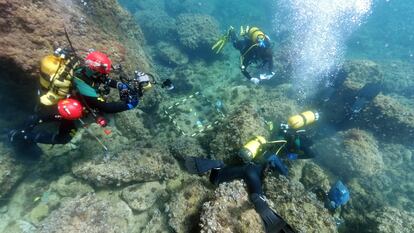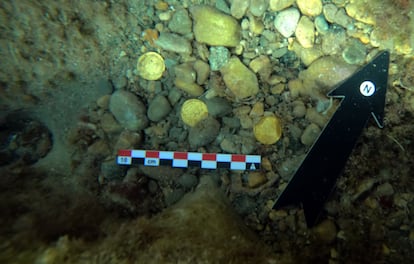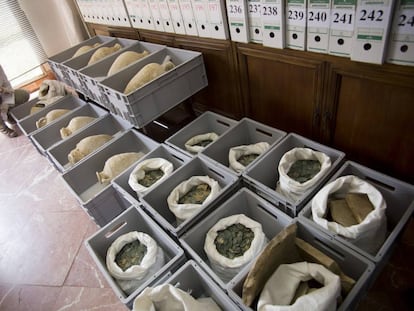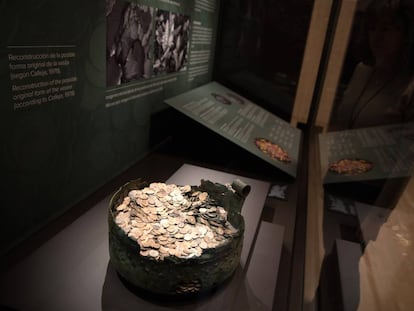Amateur divers find ‘perfectly preserved’ Roman treasure in Spain
‘It’s incredible, it’s every child’s dream,’ says Luis Lens about the 53 gold coins with legible inscriptions that date back to the 4th and 5th centuries, and illustrate the empire’s decline

Every summer, the brothers-in-law Luis Lens and César Gimeno and their respective families spend their vacations in Xàbia, a popular tourist resort on Spain’s Mediterranean coast. The two men spend their days snorkeling and free diving “with technical equipment worth €10, consisting of swimsuit, masks, snorkels and flippers,” jokes Lens. Their only aim is to enjoy the underwater scenery and “clean up the garbage” they find as they do. On August 23, a flash on a rock at a depth of about seven meters in the bay of Portitxol made Lens think he had found “what looked like a 10-cent coin.”
Before returning to the boat, Lens decided to retrieve the coin. “It was in a small hole, like a bottleneck,” he says. When he came aboard, he cleaned it and discovered “an ancient image, like a Greek or Roman face,” and thought it had come off a piece of jewelry. Lens and Gimeno went back down to the site and, “using the corkscrew on a small Swiss Army knife from the boat,” spent two hours unearthing more coins “embedded in a rock crevice.” In all, the space contained a treasure trove consisting of 53 gold coins dating between the 4th and 5th centuries, when the Western Roman Empire was in decline. According to experts, it has turned out to be one of the largest collections of its kind in Europe.
After consulting with their families, Lens and Gimeno decided to report the discovery to the local authorities the following day. “We took the eight coins we had found and put them in a glass jar with some sea water,” says Lens, who subsequently returned three times to the site with his brother-in-law and specialists in underwater archaeology from the city of Xàbia, the University of Alicante (UA) and the Spanish Civil Guard. Altogether, they extracted 53 coins from the seabed, three nails that are probably made of copper as well as deteriorated lead remains that seem to be part of a chest that would have originally contained the coins, as described by the UA. “It’s incredible, it’s every child’s dream to find a treasure,” says Lens.

“Sets of gold coins are not common,” says Jaime Molina, head of the excavation and a professor of ancient history at UA, which has been conducting surveys for three years in the bay of Portitxol, “where the ships from the [Roman province in Iberia of] Baetica stopped before leaving for the Balearic Islands on their way to Rome.” Even less common are coins found in such a “perfect state of preservation.” The team led by Molina has been able to identify and associate the coins to the Roman emperors Valentinian I (three coins), Valentinian II (seven), Theodosius I (15), Arcadius (17) and Honorius (10). There is also one unidentified coin. “There are no remains of sunken ships in the area where they were found,” says Molina. “So it was probably a voluntary act of concealment from advancing Barbarians, in this case, the Alans. The find speaks to us of a context of fear, of a world that is ending – that of the Roman Empire.”
According to the study so far, the coins must have belonged to an important landowner in the area. Between the 4th and 5th centuries, “the cities were in decline and power had shifted to the large Roman villas, to the countryside,” says Molina. “Trade has been stamped out and the sources of wealth become agriculture and livestock.” Faced with the advance of barbarian tribes, one of these landlords “must have decided to gather the gold coins, which did not circulate but were accumulated to determine the wealth of a family.” He presumably took them out in a boat and sunk them in a chest in the bay. “And then he must have died because he did not return to retrieve them,” adds Molina.
The find helps illustrate a historical period when Suevi, Vandals and Alans were raiding the area, leading to the definitive end of the Roman Empire in the Iberian peninsula beginning in 409 AD, sayd the UA in a statement.
After finishing the study, which will try to determine all the economic history the coins can provide such as “where the coins were minted between the years 360 and 409, the alloy used and their circulation,” the treasure will be restored by the UA’s University Institute of Archaeology and Historical Heritage and then exhibited at the Soler Blasco Archaeological and Ethnographic Museum in Xàbia. The regional government of Valencia has allocated €17,800 for the underwater excavation of the site where the coins were found. Meanwhile, Lens and Gimeno and their families have been left with a unique adventure to treasure.
English version by Heather Galloway.
Tu suscripción se está usando en otro dispositivo
¿Quieres añadir otro usuario a tu suscripción?
Si continúas leyendo en este dispositivo, no se podrá leer en el otro.
FlechaTu suscripción se está usando en otro dispositivo y solo puedes acceder a EL PAÍS desde un dispositivo a la vez.
Si quieres compartir tu cuenta, cambia tu suscripción a la modalidad Premium, así podrás añadir otro usuario. Cada uno accederá con su propia cuenta de email, lo que os permitirá personalizar vuestra experiencia en EL PAÍS.
¿Tienes una suscripción de empresa? Accede aquí para contratar más cuentas.
En el caso de no saber quién está usando tu cuenta, te recomendamos cambiar tu contraseña aquí.
Si decides continuar compartiendo tu cuenta, este mensaje se mostrará en tu dispositivo y en el de la otra persona que está usando tu cuenta de forma indefinida, afectando a tu experiencia de lectura. Puedes consultar aquí los términos y condiciones de la suscripción digital.
More information
Archived In
Últimas noticias
Maduro pleads not guilty before the federal court in New York: ‘I am still the president of Venezuela’
A new test can detect Alzheimer’s from a finger prick
UN team enters Sudanese city of El Fasher after paramilitary massacre: ‘It’s like a ghost town’
A recipe for resistance: Indigenous peoples politicize their struggles from the kitchen
Most viewed
- Gilles Lipovetsky: ‘If you want to live better and fall in love, take Prozac, don’t look to philosophy’
- Alain Aspect, Nobel laureate in physics: ‘Einstein was so smart that he would have had to recognize quantum entanglement’
- Alvin Hellerstein, a 92-year-old judge appointed by Bill Clinton, to preside over Maduro’s trial in New York
- Why oil has been at the center of Venezuela-US conflicts for decades
- Maduro’s downfall puts China’s relationship with Venezuela to the test











































